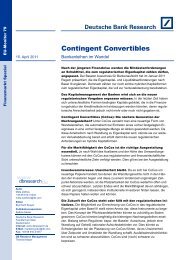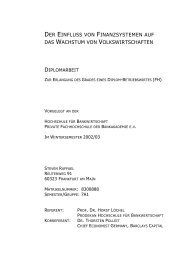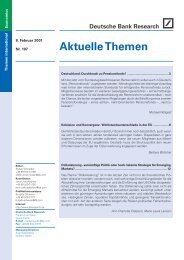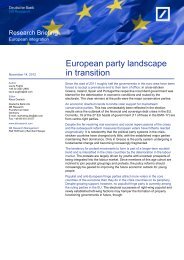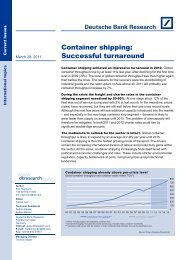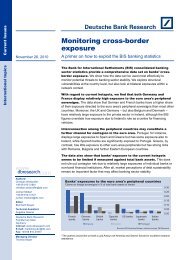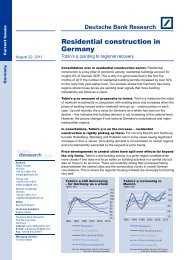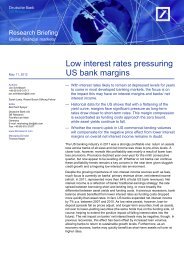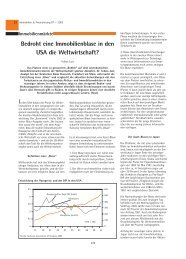Dynamic diversity opens up opportunities - Deutsche Bank Research
Dynamic diversity opens up opportunities - Deutsche Bank Research
Dynamic diversity opens up opportunities - Deutsche Bank Research
You also want an ePaper? Increase the reach of your titles
YUMPU automatically turns print PDFs into web optimized ePapers that Google loves.
Employee qualifications are key factor<br />
of competition<br />
Where do firms face recruiting<br />
problems and why<br />
HU<br />
IT<br />
CZ<br />
SI<br />
LT<br />
FI<br />
DE<br />
PT<br />
EU-27<br />
EL<br />
PL<br />
FR<br />
EE<br />
ES<br />
LU<br />
UK<br />
-100 0 100<br />
Lack of skilled labour<br />
Skilled labour/Personnel too expensive<br />
Source: Eurobarometer Survey 2006<br />
30<br />
Current Issues<br />
of skilled labour. Labour streams westwards have no small influence<br />
on the countries of origin, and can even lead to a medium-term<br />
slowing of economic growth. Employers in countries with a lack of<br />
skilled employees stated that they have a 15-20% job vacancy rate<br />
on average. German entrepreneurs have less reason to complain<br />
than other European nationals: only around 5% of the jobs remained<br />
unfilled in 2006. About half of the SMEs Europe-wide say that,<br />
altogether, they have no problems in their search for suitable staff.<br />
Since the unemployment numbers in all the member countries are<br />
higher than their natural rate of unemployment, it is, in the short run<br />
at least, not so much the number of workers available that will make<br />
the difference as their qualifications and distribution. If countries are<br />
unable to dissuade their skilled labour from migrating abroad,<br />
companies will face gaps in their headcount. On the other side of<br />
the coin, 5% of the surveyed EU firms also say they have registered<br />
a lack of unskilled labour. Furthermore, worries focus on the skill<br />
shortages exhibited by company founders and those in their inner<br />
circle, which is very much considered a more serious problem than<br />
the matter of SME funding. 42<br />
Cost development<br />
A further problem for SMEs is the cost of personnel. It holds at least<br />
for Germany that SMEs have a wage cost advantage over large<br />
companies. This is partly attributable to the fact that large<br />
companies tend to employ a greater share of highly skilled workers,<br />
and partly that the ancillary labour costs at large companies are<br />
higher. However, SME processes are at the same time considerably<br />
more labour-intensive, with personnel costs accounting for 23.3% of<br />
total costs, or nearly 10 percentage points more than at large<br />
companies. This puts the wage cost advantage back into a<br />
reasonable perspective. According to a Eurobarometer survey 43<br />
particularly Hungarian entrepreneurs (over 70%) feel that expensive<br />
labour limits their corporate success. In Germany, 35% of those<br />
surveyed agreed with this statement. The wage level in Hungary is<br />
about one-third below the EU level, but it has risen strongly over the<br />
past few years. Since the increase in productivity has not kept pace<br />
with the rise in wages, personnel is relatively expensive. The gap<br />
between productivity and wage demands may continue to cause<br />
problems for all companies in future, and naturally not just SMEs.<br />
The assumption that company location is decisive for a sufficient<br />
s<strong>up</strong>ply of qualified labour is not borne out in Germany. It is even to<br />
be seen that companies from small towns or rural areas have fewer<br />
problems in recruiting personnel than SMEs in urban<br />
agglomerations. In large cities, the competition for skilled labour is<br />
tougher: both from similarly sized peers and also from large<br />
companies. Additionally, the same survey determined that 62% of<br />
the SMEs approached do little strategic planning in the area of<br />
personnel marketing, but 90% regard the building of employer<br />
branding as the most promising weapon in the war for talent. SMEs<br />
have to struggle at regular intervals to overcome their reputation of<br />
being ―wallflowers‖.<br />
42 SUERF Conference 2008, Von Derwall (ING).<br />
43 Eurobarometer survey of the European Commission 2006/2007.<br />
22 April 15, 2009



